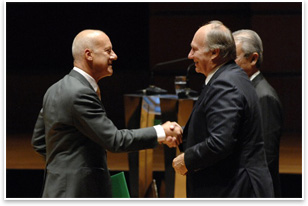
|
Aga Khan Awards Nine Muslim Projects of Excellence Summary: Addressing the contemporary needs of environment, collaboration, education, and use of modern technology, the 2007 Aga Khan Award for Architecture recognized nine projects September 4 for how they improve living conditions in poor countries. Given every three years since 1977, the Aga Khan Award will share $500,000 among the awarded projects. The awards, named for the spiritual leader of the Shiite Ismaili Muslims—15 million people living in 25 countries—were announced by Malaysia Prime Minister Abdulla Ahmad Badawi in a ceremony at the Petronas Twin Towers, winner of a 2004 award. In this, the 10th round of awards and 30th anniversary of their inception, another Malaysian high-rise received recognition, the University of Technology Petronas, designed by Foster + Partners and GDP Architects. The jury recognized the high-tech architecture as emblematic of the importance of higher education in this rapidly developing nation. The Moulmein Rise Residential Tower in Singapore, recognized as an innovative design for tropical high-rise living, earned an award for WOHA Architects, Singapore. The Royal Netherlands Embassy in Addis Ababa respects its context while fulfilling its functional role. Dutch architects Dick van Gameren and Bjarne Mastenbrock received the award together with the Ethiopian firm, ABBA Architects.
Improvements to the Central Market in Koudougou, Burkina Faso, strengthened a community’s economic well-being using the area’s traditional building material, stabilized earth. Principal architect Laurent Schaud shared the award with the Koudougou Municipality and the Swiss Agency for Development and Cooperation. The other awarded projects were:
|
||
Copyright 2007 The American Institute of Architects. All rights reserved. Home Page |
||
news headlines
practice
business
design
For more information on the Aga Kahn Award for Architecture, visit the Aga Kahn Development Network Web site.
Captions:
The University of Technology Petronas, Malaysia.
Sir Norman Robert Foster, Hon. FAIA, the 1994 AIA Gold Medalist, receives his 2007 Aga Kahn Award from His Highness the Aga Kahn.


 The School in Rudrapur, in Bangladesh, required only four months for local workers and volunteer architects from Germany and Austria—Anna Heringer and Eike Roswag—to build it from local materials. It is a new model of school construction that is beautiful, simple, and humane, stated the awards release.
The School in Rudrapur, in Bangladesh, required only four months for local workers and volunteer architects from Germany and Austria—Anna Heringer and Eike Roswag—to build it from local materials. It is a new model of school construction that is beautiful, simple, and humane, stated the awards release.